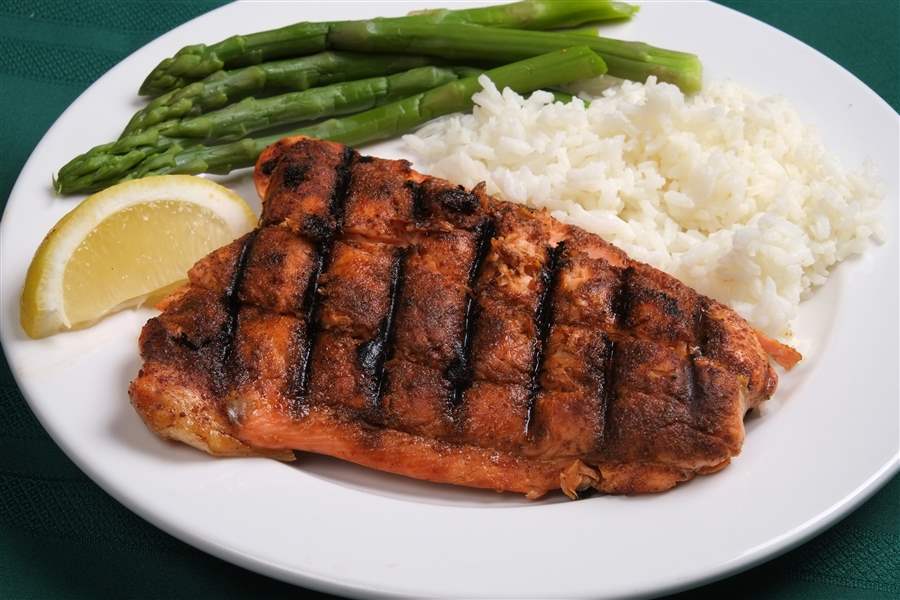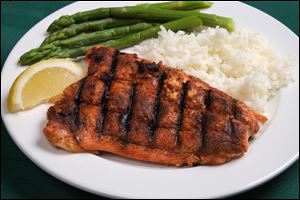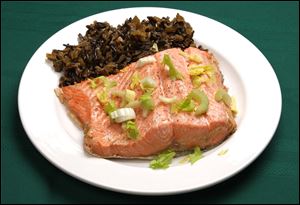
Wild Salmon: It's in season, and it's way better than the farmed variety
6/4/2013
Grilled salmon with asparagus, and white rice
The Blade/Dave Zapotosky
Buy This Image

Perhaps you've seen one of those film clips of a bear standing in a river in Alaska. Salmon swimming upstream to spawn leap out of the water and land right in the bear's open mouth.
It's nature's original take-out food, delivered while you wait.
You certainly can't blame the bear. Wild salmon is one of those sublime foods that seem to be loved by everyone, ursine and otherwise. With a flavor that is robust but never overpowering, a rich texture, and a distinctive color — so distinctive it's just called "salmon" — wild salmon is all the more tantalizing because its season is so brief.
Fortunately for us, that season is right now. Stores and fish markets are full of the stuff, and we can stand there, bearlike, and pick out what we want.
Farmed salmon just isn't the same thing. It will do in a pinch because it is available year-round (and it is considerably less expensive), but it has much more fat and much less flavor than the fish in the wild. It also is lighter in color — call it pale salmon — because of a difference in diets. Wild salmon primarily eat krill, a small, shrimp-like crustacean that reddens their flesh. Farmed salmon are often fed whatever is cheapest, which these days can even include corn.
At the moment, we are in the season for king salmon (also known as Chinook) and sockeye. King salmon is fattier than sockeye and also thicker; the sockeye texture is meatier. As one online commenter has suggested, you can compare king salmon to a rib eye steak while sockeye is more like a sirloin.

Roasted salmon, steamed salmon, and grilled salmon.
For this story, I went with the sockeye for one equally good consideration: It was a couple of bucks cheaper per pound (although "cheaper" here is strictly a relative term). Wild salmon is great, but it's not an everyday kind of meal.
Because wild salmon has such an enticing flavor, I wanted to prepare it simply with nothing to overpower the taste of the fish. No blackened salmon for me, not this week, although actually the fiercely hot blackening spices are a perfect counterpoint to the cool fattiness of the salmon. I wanted to savor this fish by cooking it the big three ways: steaming, roasting, and grilling.
Steaming a fish is easy: just suspend it above boiling liquid until it is done. It is what you serve with it that makes a difference, and for that I turned to one of America's best-known food writers, Mark Bittman. Mr. Bittman may be a bit imprecise in his recipes at times (seriously, dude, you can't cook wild rice in 30 minutes), but only he could think of steaming salmon over wild rice and a mess of celery.
I used less of a mess of celery than he called for — do you really want to eat a quarter-pound of it with your wild rice and salmon? — and of course I cooked the wild rice the 50 or 60 minutes it actually takes to be done. But the idea itself was brilliant: both the celery and the wild rice have an umami earthiness that blends their flavors together particularly well and makes a stunning foil for the salmon's buttery richness.

Grilled salmon with asparagus, and white rice
And to make matters even better, it's all cooked together in one pot. The celery and rice are sautéed with onion and garlic, and then a liquid is added to cook the rice (I used vegetable broth). A few minutes before the rice is done, you just lay the salmon on top and let it steam as the rice finishes.
For the roasted salmon, I followed the example of the Dining at Delmonico's cookbook and seared the fish on both sides before finishing it in the oven. This dish gets its flavor punch from a marinade that goes on for anywhere from one to eight hours.
The marinade is easy, though it can take a little time to strip the thyme leaves from their stems. All it takes is olive oil, rosemary, thyme, onion, and garlic. That combination, combined with the searing, results in a salmon that is crisp on the outside, moist on the inside, and flavorful all the way through.
Because of its fatty content, salmon also lends itself extraordinarily well to grilling. It's hard to beat simply brushing a fillet with olive oil and seasoning it with salt and pepper before throwing it on the grill, but I wanted to try. A rub seemed like the perfect solution. I found a recipe for a sweet and spicy rub online, followed the link back to where it said it came from, then followed the link back to where that one said it came from, and eventually discovered it was created by TV host and cookbook author Ellie Krieger.

Steamed wild salmon with brown rice and celery.
As it turns out, finding out who created the rub was actually harder than making it. It's brown sugar and chili powder, with cumin mixed in as a curveball, an unexpected twist. But cumin goes well with many fish (try it with grouper or haddock) and salmon is among them. Ms. Krieger's rub is a little bit of sweet, a little bit of heat, and a little bit of cumin.
I served it simply with a squeeze of lemon, plain white rice on the side, and a quick salad.
Because it is made with wild salmon, it is a meal good enough to serve to guests. But this time of year, when wild salmon practically leaps onto your plate, it's also easy enough to make for your family.
Contact Daniel Neman at: dneman@theblade.com or 419-724-6155.
RECIPES
Roasted Salmon
¾ cup light olive oil
4 sprigs rosemary
3 cloves garlic, peeled and chopped
1 large onion, peeled and chopped
2 tablespoons fresh thyme leaves
6 (7-ounce) boneless, skinless salmon fillets
Coarse salt and freshly ground black pepper to taste
2 tablespoons canola oil
Combine the oil with the rosemary, garlic, onion, and thyme in an extra-large resealable plastic bag. Add the salmon, seal, and toss to coat the fish. Refrigerate for 1 hour or up to 8 hours.
When ready to cook, preheat the oven to 375°. Alternatively, oil a grill and preheat it to high.
Remove the fish from the bag and, using your fingertips, clean off any small pieces of the marinating vegetables or herbs. Season both sides with salt and pepper.
Heat the oil in a large ovenproof sauté pan over medium-high heat (you may need 2-3 pans to cook 6 fillets). When it is very hot but not smoking, add the salmon, skin side up. Sear for 4 minutes, or until evenly browned on the flesh side. Turn the fish and sear the skin side for 2 minutes. Transfer the pan to the preheated oven and roast for 2-5 minutes, depending on the fillet's thickness, until the flesh flakes easily with a fork. Alternatively, grill the salmon for about 5 minutes per side on the hot grill.
Yield: 6 servings
Source: Dining at Delmonico's, by Judith Choate and James Canora
Wild Rice with Celery and Steamed Salmon
1 head celery, about 1 pound
2 tablespoons olive oil
1 onion, chopped
1 tablespoon minced garlic
1 cup wild rice
3½ cups vegetable or fish broth, or water
1 bay leaf
Salt and black pepper
2 thick salmon steaks or fillets
Lemon wedges
Remove 5-6 stalks from the celery and chop them. Peel away the other stalks that surround the celery heart (the tender part in the middle) and reserve for future use. Reserve the celery heart and its leaves.
Put the oil in a deep skillet over medium heat. When it's hot, add the onion and garlic and cook, stirring, until the onion begins to soften, about 5 minutes. Add the chopped celery and wild rice and continue to cook, stirring frequently, until the rice is fragrant and glossy, just a couple of minutes. Stir in the stock, bay leaf, and some salt and pepper and bring to a boil.
Adjust the heat so that the mixture bubbles gently, cover, and cook undisturbed until the rice is very tender and just beginning to burst, 50-60 minutes. At this point there should still be a little liquid at the bottom of the pan (no more than about ¼ inch); if not, add a little water.
Put the salmon on top of the rice, sprinkle with a little salt and pepper, and replace the lid. Steam until the fish is done (a thin knife can be inserted with little resistance), 5 minutes for fillets or 5-10 minutes for steaks. Meanwhile, chop the reserved celery heart and leaves. Remove the salmon and cut each steak or fillet in half. Fluff the rice with a fork, discard the bay leaf, and taste and adjust the seasoning. Serve the fish on top of the rice, topped with the chopped celery leaves and heart and the lemon wedges.
Yield: 4 servings
Source: Adapted from The Food Matters Cook Book, by Mark Bittman
Salmon with Sweet & Spicy Rub
Cooking Spray
2 tablespoons packed light brown sugar
1 tablespoon chili powder
1 teaspoon ground cumin
1/8 teaspoon salt
1/8 teaspoon pepper
6 (6-ounce) salmon fillets, skin and any pin bones removed
1 tablespoon olive oil
Coat your grill or a grill pan with cooking spray and preheat over medium heat. While the grill is heating, combine the brown sugar, chili powder, cumin, salt, and pepper. Brush each salmon fillet with ½ teaspoon of the oil, then rub each fillet with about ½ tablespoon of the spice mixture.
Grill the salmon, flesh side down, until charred, 4-5 minutes. Flip the salmon and cook another 5-6 minutes for medium doneness. For well-done fish, cook an additional 1-2 minutes. Remove to a platter and serve immediately.
Yield: 6 servings
Source: By Ellie Krieger, via Food Network